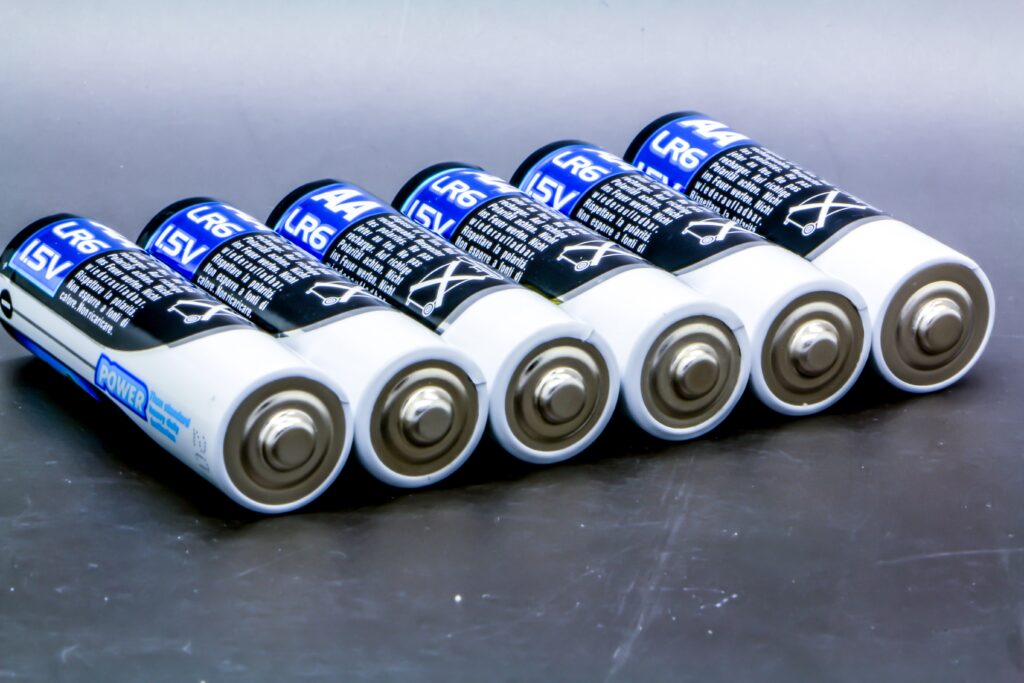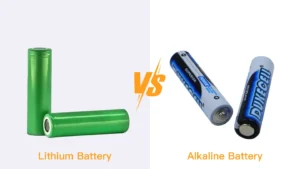AA batteries, commonly used in a variety of electronic devices, are typically composed of several key materials and components. Here’s a breakdown of what AA batteries are generally made of:
Overview of AA Battery Types and Components
AA batteries, commonly used in household devices, are composed of various materials depending on their type. The main types of AA batteries include Alkaline, Nickel-Cadmium (NiCd), Nickel-Metal Hydride (NiMH), and Lithium-Ion batteries. Each type has distinct materials and characteristics.
Alkaline Batteries:
What are alkaline batteries made of?
Alkaline batteries have become a staple in many households and industries due to their reliability and power.Understanding the components of these batteries can reveal their performance characteristics and environmental impact.
Alkaline batteries are known for their higher energy output compared to other types of batteries. So, what are alkaline batteries made of? They typically consist of a zinc anode, a manganese dioxide cathode, and an alkaline electrolyte (usually potassium hydroxide). These components work together to create a powerful and efficient power source.
- Anode (Negative Terminal): The anode of an alkaline battery is made from zinc. This metal is chosen for its electrochemical properties that facilitate the flow of electrons from the anode to the cathode, thus generating an electric current.
- Cathode (Positive Terminal): The cathode is composed of manganese dioxide. This material reacts with the alkaline electrolyte to produce an electric current.
- Electrolyte: The electrolyte in alkaline batteries is a potassium hydroxide solution. It helps to conduct electricity between the anode and cathode, enabling the chemical reactions that produce electricity.
How are alkaline batteries manufactured?
The process of manufacturing alkaline batteries involves combining the aforementioned components in a precise manner. The negative terminal, or anode, is made from zinc powder and housed in a steel can. The positive terminal, or cathode, is typically a carbon rod coated with manganese dioxide. This is then placed in the center of the anode can, and the electrolyte is added. What are alkaline batteries made of? The answer lies in this meticulous construction, ensuring the controllability and power of the chemical reactions.
Alkaline batteries are composed of zinc, manganese dioxide, and an alkaline electrolyte. These components combined create a battery that is both powerful and efficient. As we continue to rely on these batteries for a variety of applications, understanding what alkaline batteries are made of is crucial for making informed choices regarding their use and disposal.
Nickel-Cadmium (NiCd) Batteries:
NiCd batteries have a cadmium anode and a nickel oxide hydroxide cathode. The electrolyte is an aqueous solution of potassium hydroxide. These batteries are rechargeable and have a high discharge rate, making them suitable for power tools and high-drain devices. However, cadmium is toxic, which raises environmental concerns about their disposal.
Nickel-Metal Hydride (NiMH) Batteries:
NiMH batteries use a metal hydride for the anode instead of cadmium. The cathode remains nickel oxide hydroxide, and the electrolyte is still an aqueous solution of potassium hydroxide. These batteries are also rechargeable and offer a higher capacity than NiCd batteries. They are commonly used in digital cameras, portable electronics, and some hybrid vehicles.
Lithium-Ion Batteries:
These batteries are quite different from the others. The anode is typically made from a compound like lithium cobalt oxide or lithium iron phosphate, while the cathode is made of graphite. The electrolyte is a solution of organic solvents containing lithium salts. Lithium-Ion batteries are known for their high energy density and are commonly used in smartphones, laptops, and electric vehicles.
Structure:
AA batteries generally have a casing made of steel or plastic to contain the internal components. A separator, usually a porous material, prevents the anode and cathode from touching while allowing ions to move between them. Additional components like current collectors (metal foils) collect and transfer the electrical current. Safety features such as pressure vents, separators, and thermal fuses are included to prevent overheating and short circuits.
Each type of AA battery has specific characteristics and applications, making them suitable for different devices and usage scenarios. The choice of battery depends on the required performance, environmental considerations, and the specific needs of the device.
Refer To: how many mah in aa battery ?

What Are Aa Batteries Made Of?
AA batteries are a household name when it comes to portable power sources. They are the workhorses that keep our remote controls, toys, and small devices humming along. But what are aa batteries made of, and what lies inside the casing that makes them so versatile?
AA batteries, also known as MN1500, LR6, or simply A1300, are among the most popular sizes of single-use batteries. Understanding what are aa batteries made of gives us insight into their performance and longevity. Typically, an AA battery is composed of a zinc canister as the anode, a cathode made of manganese dioxide, and an electrolyte usually consisting of ammonium chloride or zinc chloride.
The Anatomy of an AA Battery
To delve deeper into what AA batteries are made of, let’s break down their components:
Anode (Negative Terminal): The anode is made of zinc and is housed in a zinc canister. This canister not only serves as the negative terminal but also provides structural support to the battery.
Cathode (Positive Terminal): The cathode is composed of manganese dioxide, which is a key element in the battery’s ability to generate a current.
Electrolyte: The electrolyte in an AA battery is often a paste of ammonium chloride or zinc chloride. It facilitates the flow of ions between the anode and cathode, enabling the chemical reactions that produce electricity.
Separator: A non-conductive material separates the anode and cathode, preventing internal short circuits while allowing ionic movement.
Casing: The outer casing of an AA battery is typically made of steel or sometimes plastic, providing a protective barrier.
How AA Batteries Work
Now that we know what are aa batteries made of, let’s look at how they generate electricity. When the battery is in use, a chemical reaction occurs at the anode where zinc reacts with the electrolyte to produce zinc ions and electrons. These electrons flow through the device, providing power. The zinc ions travel through the electrolyte to the cathode, where they react with the manganese dioxide and the electrons to form a new compound.
The Role of Each Component
- Zinc (Anode Material): Zinc is chosen for its electrochemical properties and because it is relatively inexpensive and non-toxic.
- Manganese Dioxide (Cathode Material): Manganese dioxide provides a large surface area for the reaction to occur, which helps maintain a steady voltage output.
- Electrolyte: The electrolyte enhances the conductivity of the battery and ensures a smooth flow of ions.
Environmental Considerations
With the increasing push for environmental sustainability, understanding what aa batteries are made of is also crucial for their responsible disposal. Both the chemicals inside and the materials of the casing can be harmful if not disposed of properly. Many countries have regulations in place for the recycling of batteries to minimize environmental impact.
When selecting AA batteries, understanding the voltage they provide is crucial for ensuring optimal performance in your devices.Our AA batteries are engineered to deliver consistent and reliable power, characterized by precise voltage measurements crucial for various applications.
Voltage Details:
The AA battery voltage typically stands at 1.5 volts for alkaline batteries, which is standard across the industry.This voltage ensures that devices perform efficiently, providing the necessary power for everything from remote controls to portable electronic devices.The voltage from aa battery is designed to match the requirements of devices that are intended for AA size batteries, thereby ensuring a perfect balance between longevity and performance.
Voltage Variations:
When discussing how many volts is a AA battery or how many volts are in a double A battery, it’s essential to note that rechargeable AA batteries might offer slightly lower voltages, around 1.2 volts, due to their different chemical composition.However, our AA batteries maintain a higher voltage of a AA battery even under high-drain conditions, which is a significant advantage for power-intensive devices.
Advanced Voltage Stability:
Our AA batteries come with an advanced formulation that not only answers the question, how many volts in an AA battery, but also enhances the AA battery volts stability over time. This means that as the battery discharges, the drop in voltage is minimized, allowing your devices to operate at optimal levels for longer periods. This stability is crucial for applications requiring a consistent voltage supply to maintain performance accuracy.
Voltage Details:
The AA battery voltage typically stands at 1.5 volts for alkaline batteries, which is standard across the industry.This voltage ensures that devices perform efficiently, providing the necessary power for everything from remote controls to portable electronic devices.The voltage from aa battery is designed to match the requirements of devices that are intended for AA size batteries, thereby ensuring a perfect balance between longevity and performance.
AA Battery Weight and Capacity Explored
How Much Does A Aa Battery Weigh?
The question “how much does a double A battery weigh?” is common among consumers who prioritize portability and ease of use. The typical weight of an AA battery varies slightly depending on the type and the materials used. On average, a standard alkaline AA battery weighs about 23 grams. For those asking specifically, “how much does aa battery weigh?” it’s important to note that our batteries are designed to be as lightweight as possible without compromising on performance.
How Many Mah Is Aa Battery?
The AA battery capacity is a critical factor that impacts how long a battery can power a device before needing replacement or recharge. Our AA batteries are engineered to offer superior AA battery capacity, which is measured in milliampere-hours (mAh). Typically, you can expect our alkaline AA batteries to have a capacity ranging from 1700 to 3000 mAh, providing long-lasting performance for devices ranging from digital cameras to portable gaming consoles.
Exploring AA Battery Dimensions and Capacity

When selecting batteries for your devices, understanding the complete specifications such as AA battery dimensions, AA battery length, and AA battery diameter is essential. Moreover, knowing the energy capacity, specifically how many mah in aa battery, plays a crucial role in matching the right battery to your device’s needs. Our AA batteries are designed with these critical factors in mind, ensuring they meet a broad range of applications with precision and reliability.
Detailed Specifications:
The standard dimensions of AA size battery include a length typically around 50.5 mm and a diameter of about 14.5 mm.These AA battery measurements make them suitable for a wide array of devices, from remote controls to sophisticated electronic equipment. The length of AA battery and its diameter are meticulously crafted to ensure a perfect fit in device compartments, providing a secure and stable power source.
Capacity Insights:
Regarding capacity, a common question is how many mah in aa battery. Our AA batteries are available in various capacities, typically ranging from 1700 to 2850 mAh. This range allows for extended use, reducing the need for frequent replacements and thereby enhancing user convenience and device uptimeThe higher mAh rating ensures that devices not only run longer but also perform at their best due to a consistent discharge rate.
Advanced Manufacturing Techniques:
We employ advanced manufacturing techniques that ensure each battery is produced with precision and consistency. The use of high-quality materials in the dimensions of AA size battery ensures durability and reliability. Our rigorous quality control processes guarantee that every battery not only meets but exceeds industry standards of performance and safety.
Insights and Innovations:
When powering devices, understanding the voltage for AA battery is crucial, as it directly influences device performance and efficiency.Knowing precisely what is the voltage of a AA battery helps in selecting the right battery for your specific needs. Our AA batteries are designed to provide consistent and reliable power, enhancing device functionality with optimal voltage output.
Standard Voltage Specifications:
Typically, the volts of a AA battery are about 1.5 volts for alkaline versions, which is ideal for a wide range of household and portable devices.For those wondering what is voltage of AA battery particularly in rechargeable forms, it generally measures around 1.2 volts due to the different chemical composition, which still effectively powers numerous devices.Our batteries maintain a stable voltage of an AA battery throughout their lifespan, ensuring your devices operate smoothly without unexpected power dips.
Wattage and Performance:
The AA battery watts refer to the power output, which combines the voltage and the current the battery can deliver.Knowing the wattage is essential because it affects how well a battery can run a device.Our AA battery voltage chart provides a detailed look at how voltage and wattage correlate, offering insights into how batteries perform under various loads.This chart is a valuable tool for users to understand battery behavior, helping in making informed decisions based on performance expectations.




